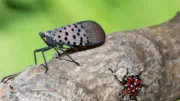It seems that this year – as with others in recent memory – there is no shortage of chipmunks.
People can learn more about these “small, agile” rodents on the Pennsylvania Game Commission’s website in a Wildlife Note penned by Chuck Fergus. It can be found under the Wildlife Notes link at www.pgc.pa.gov/Education.
The chipmunk’s taxonomic name is tamias striatus. The note said “tamias means collector and keeper of provisions, and striatus refers to the animal’s prominent body stripes” or in other words, striped collector.
Fergus mentioned in the note that the chipmunk has other colloquial names including grinny, chippie, hackle and rock squirrel. He wrote that little rodent is closely related to various squirrels and “surprisingly, the woodchuck.”
Chipmunks are omnivorous which means they’ll eat just about anything. Items on their menu include fruits, nuts, garden vegetables (NO!), bird eggs, insects, frogs, small snakes and even baby mice and birds (Eww).
Fergus wrote that chippies will eat their food on the spot or carry it away for hoarding.
The article included some interesting observations on just how much chipmunks can stuff into their chubby cheeks.
“One observer noted 31 corn kernels, another 32 beechnuts, and a third 70 sunflower seeds in the cheek pouches,” Fergus wrote.
This blogger wondered just how one gets to be a chipmunk pouch-stuffing observer and how they don’t lose track of all the items being stuffed.
“Tamias striatus is a vocal creature,” Fergus wrote.
This is clearly evident when one enters the forest, yard and wood lots to hear their alarm calls. The shrill “chips” send this blogger’s canine walking companions into a frenzy and prompts a desperate search to find the chipmunk callers.
The note also mentioned the chipmunk population saying that some researchers estimate that average population at two to four chipmunks per acre of adequate habitat.
For those trying to keep the rodents out of their homes, gardens and potted plants, two to four is two to four too many.
Fergus wrote that “predation does not usually have a great effect on local populations” (Darn it!).
The note mentioned that “few chipmunks inhabit swamps or marshland.” It said that if a beaver dam floods a valley, chipmunks will move out.
So, those dealing with chipmunk issues may consider the beaver-dam flooding option. However, that choice comes with some problems of its own.
This blogger has had some limited success with a small animal repellent purchased at a local farm store.
However, the repellent has a heavy garlic and fish oil base which repels more than just chipmunks (namely the gardener, too.)
While the potted plants no longer appear to be stashes for nature’s little hoarders, one can hardly stand the aroma of garlic-scented petunias and pansies.
Meanwhile, the neighborhood doe has made almost daily appearances on the trail camera. However, her young ones have not.
The purple clematis is covered with blooms and the forest pathways are a green, green scene.
A Walk in the Woods contains photos from newsroom staffer Anna Applegate’s daily jaunts around her neck of the woods. Tagging along on the treks are dogs Buford, Sherman and Sadie, and goats Kyle and Kennedy. Applegate manages the Good Times and can be emailed at bigdogs.thederrick@gmail.com.














































